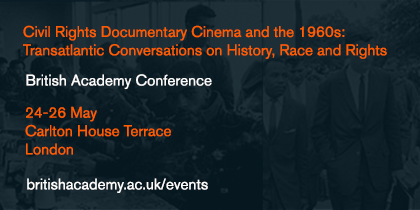
May 10, 2016, by Guest blog
Civil rights on film: Eyes on the Prize
Cinema is central to our understanding of civil rights movement history. Join filmmakers and historians at the British Academy on 24, 25 and 26 May to discuss the relationship between history, activism and documentary filmmaking.
The Civil Rights Movement exists in “grainy black-and-white” (Obama, 1995)
When Barack Obama published Dreams From My Father in 1995, he confided that the Civil Rights Movement seemed to him to exist in “grainy black-and-white” as “a series of images, romantic images, of a past I had never known. . . . . A pair of college students, hair short, backs straight, placing their orders at a lunch counter teetering on the edge of riot. SNCC workers standing on a porch in some Mississippi backwater trying to convince a family of sharecroppers to register to vote. A county jail bursting with children, their hands clasped together, singing freedom songs.”
What Obama described as romantic then is revealing now. The passage is textured with yearning: partly the regret that he was too young to have been part of a social movement that changed the nation; partly a worry that this activist past was not a useable past but risked being left remote, disconnected and “over,” even though its history was so recent. In 1967 when Alice Walker published her first essay, ‘The Civil Rights Movement: What Good Was It?’ she had described the movement as iconoclastic: “a call to life” for people who did not exist “either in books or in films or in the government of their own lives.” Grass-roots activism caught fire across the South and students were the fire-starters. In February 1960, four black students at the Agricultural and Technical College in Greensboro, North Carolina sought to smash Jim Crow etiquette in its quotidian forms by refusing to leave a lunch counter where they knew they would be denied service. Their protest would impact on southern custom to the extent that only two months later it was estimated that 50,000 people had protested at lunch counters across 100 towns and cities. Their direct action would develop into the student movement represented by SNCC: the Student Nonviolent Coordinating Committee founded in 1960.
When Obama was preparing his memoir, though, it was hard to imagine social action as such an effective force. In 1981 historian Clayborne Carson, who will be participating in the conference, had written In Struggle: SNCC and the Black Awakening of the 1960s in order to preserve the “shock troops” of the Civil Rights Movement from what he called “the fate of obscurity.” In 1987 Henry Hampton would release the landmark multi-part 14-hour television series Eyes on the Prize.
Eyes on the Prizewas signally important. Obama would not have been able to visualise those images of the movement without it.
Hampton and his team recovered and permanently fixed the images of the movement in the public imagination, from the Montgomery bus boycott, the sit-ins, freedom rides, mass meetings, the courage and the dangers for African Americans in the rural South who tried to register to vote, direct action confrontations in Mississippi and in Selma. And SNCC workers, like Julian Bond, in whose memory we are meeting in London, and Judy Richardson who joins us to talk about her experience in SNCC were at the heart of the movement. By 1965 SNCC had the largest field staff of any civil rights organisation in the South. Judy Richardson brought that experience to bear as a member of the production team on Eyes on the Prize. Academic histories or biographies or memoirs are rarely bestsellers—Obama’s memoir was not until he became President— but a documentary can reach viewers who might not choose to read a history book.
When Eyes on the Prize was released in 1987 it reached 1000 million viewers.
Else wrote to me recently: “Eyes on the Prize re-introduced Emmett Till to a world that had largely forgotten him and showed the courage it took to cross the Edmund Pettus Bridge in Selma [an episode we will screen and discuss at the conference]. It chronicled that great expansion of American democracy through legal victories, direct action, voter registration, and legislation. Hampton was not afraid to show the movement’s raw realities: conflicts between secular and religious leaders, the shift toward black power and armed black resistance in the face of savage white violence. Henry Hampton utterly changed the way social history is told in the media, taught, and remembered today.”
January 2017 will be the 30th anniversary of the initial broadcast Jon Else, Hampton’s series producer and an award-winning documentary filmmaker in his own right, will be commemorating that anniversary in a monograph he has called True South: Henry Hampton and “Eyes On The Prize. After having relived the experience in the act of writing about it, Else, joins us at the British Academy to think about the tumultuous 18 months over 1985 and 1986 when the documentary series came together and to help us think through the different forms of storytelling that contribute to the continually evolving historiography of the civil rights movement.
Sharon Monteith, the Centre for Research in Race and Rights, University of Nottingham
Sharon.Monteith@nottingham.ac.uk
No comments yet, fill out a comment to be the first

Leave a Reply